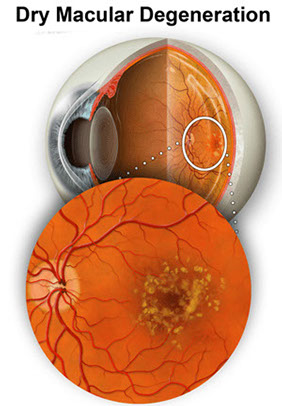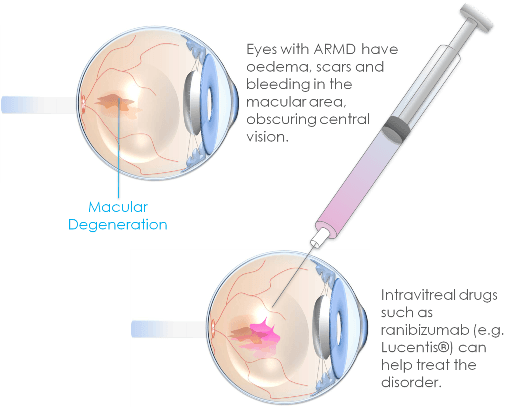EYES
KNOW YOUR
Age-Related Macular Degeneration (AMD)
Introduction
Age-related macular degeneration (AMD) is a painless eye condition that generally leads to the gradual loss of central vision but can sometimes cause a rapid reduction in vision
Central vision is used to see what is directly in front of you. In AMD, your central vision becomes increasingly blurred, leading to symptoms such as:
• Difficulty reading because the text appears blurry
• Colours appearing less vibrant
• Difficulty recognizing people's faces
AMD usually affects both eyes, but the speed at which it progresses can vary from eye to eye. AMD does not affect the peripheral vision (outer vision), which means it will not cause complete blindness.
Figure : Vision of a normal person
Figure : Vision of a AMD patient


Types of AMD
(i) Dry AMD develops when the cells of the macula become damaged as a result of a build-up of waste products called drusen. It is the most common and least serious type of AMD, accounting for around nine out of 10 cases.
• The loss of vision is gradual, occurring over many years. However, an estimated one in 10 people with dry AMD will then go on to develop wet AMD.
(ii) Wet AMD develops when abnormal blood vessels form underneath the macula and damage its cells (doctors sometimes refer to wet AMD as neovascular AMD).
• It is more serious and without treatment, vision can deteriorate within days.


Figure : Dry AMD
Figure : Wet AMD
Who is affected
For reasons that are unclear, AMD tends to be more common in women than men. It is also more common in Caucasian and Chinese people in ethnicity than people from other ethnic groups.
As would be expected by its name, age is one of the most important risk factors for AMD. The condition is most common in people over 50 and it's estimated that one in every 10 people over 65 have some degree of AMD.

How AMD is treated
There is currently no cure for either type of AMD. With dry AMD, treatment is mostly based on helping a person make the most of their remaining vision, such as using magnifying lenses to help make reading easier.
There is also some evidence to suggest that a diet rich in green leafy vegetables may slow the progression of dry AMD.
Wet AMD can be treated with a type of medication called anti-VEGF medication, which aims to stop your vision getting worse by helping prevent further blood vessels developing. In some cases laser surgery can also be used to destroy abnormal blood vessels. Early diagnosis and treatment of wet AMD is essential in reducing the risk of severe loss of vision.
Figure : Lucentis Injection

LOCATION
Ipoh
23-27 Jalan Kamaruddin Isa
(Jalan Fair Park)
31400 Ipoh Perak
Malaysia
Taiping
27 Jalan Medan Taiping 5
Taman Medan Taiping
34000 Taiping Perak
Malaysia
CONSULTATION HOURS
Ipoh
Mon., Tue. & Fri. : 2.00 pm - 5.00 pm
Wed. & Thurs : 9.00 am - 1.00 pm
Sat. : 9.00 am - 12.00 pm
Taiping
Monday : 8.30 am - 1.00 pm
Wednesday : 2.00 pm - 4.00 pm
Saturday : 2.30 pm - 6.30 pm
© 2014 All Right Reserved, Chew Eye Specialist & Surgery Sdn. Bhd.
